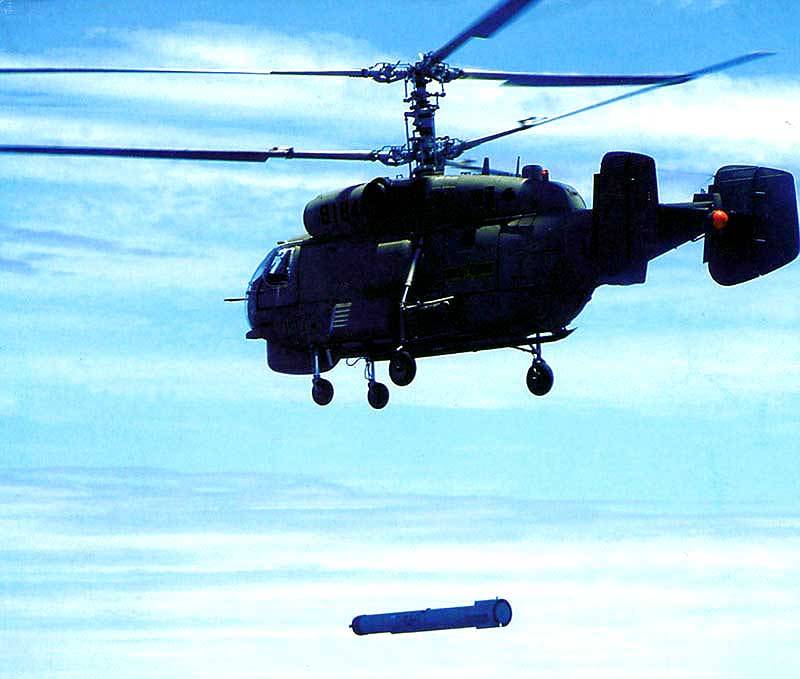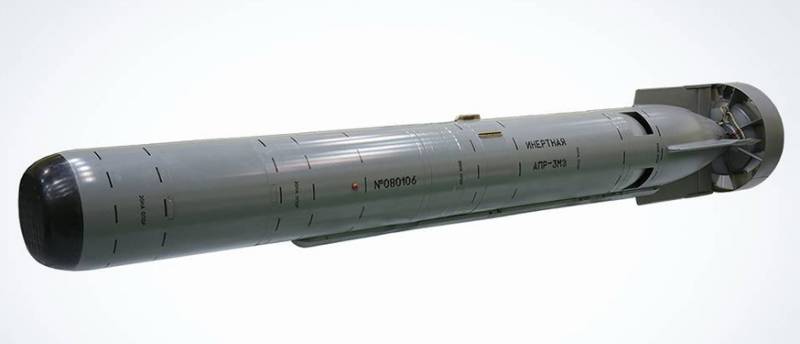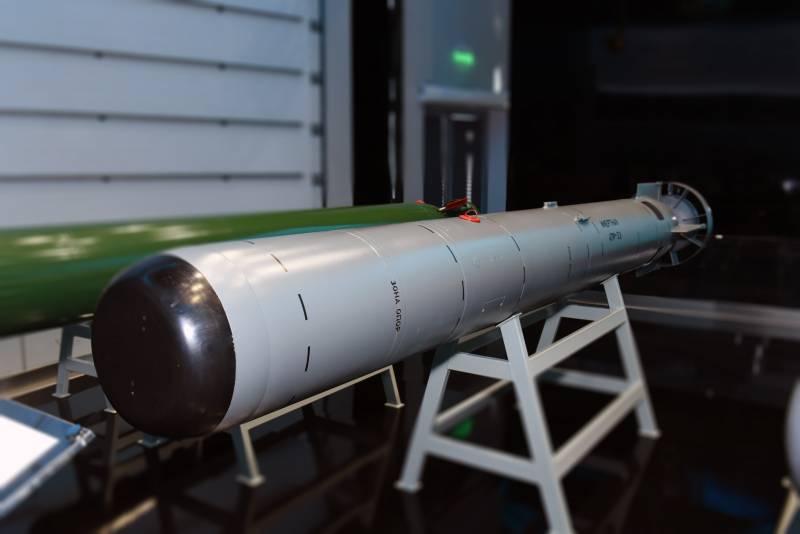Aviation anti-submarine missile APR-3ME "Grif" and its commercial prospects
This year, the Russian industry has launched mass production of the latest aviation anti-submarine missile APR-3ME "Grif". This is the latest development from the whole family, built using the most modern solutions and components, which gives it advantages over previous samples.
Rocket for export
Work on the first model of the future family, the APR-3 Orel-M rocket, started back in the late sixties, but it entered service only in 1991. Soon there was an export version, a training modification, etc. In the tenths, the State Scientific and Production Enterprise "Region" (part of the Tactical Missile Armament Corporation) created the modernized APR-3M missile. In 2019, its serial production started; the missile entered the Ka-27M helicopter ammunition load.
At exhibitions in 2017, KTRV showed for the first time several new developments, incl. the export version of the new anti-submarine missile is the APR-3ME "Grif" product. It was reported that this modification is significantly different from the base sample and shows different tactical and technical characteristics.
The first demonstration of the rocket at the exhibition gave an actual start to the process of finding customers. Later, in 2019, the development organization indicated that the launch of serial production of the APR-3M allows it to start promoting the export rocket on the market. The details of this process were not disclosed over the next years.
During the IMDS-2021 salon, the KTRV management spoke about the start of the serial production of the Griffins. By this time, the State Research and Production Enterprise "Region" had managed to manufacture and deliver the first batch of missiles to the customer. At the same time, they did not name the customer, the number and cost of the missiles.

Drop of the APR-3 rocket by the Chinese Ka-28 helicopter
It should be noted that there are contradictions in recent reports. So, the letter "E" in the product index indicates its export destination. However, some domestic media write that the new "Grif" is entering service with the Russian naval aviation. Considering the previous news, it can be assumed that the new missiles really go abroad, and errors have crept into publications on this topic.
Technical appearance
The APR-3ME product is an aviation ammunition for fighting submarines of all classes and types. The missile is capable of finding and hitting targets on the surface and underwater, as well as at periscope depth. The product is compatible with all major domestic anti-submarine aircraft and helicopters. It is likely to be integrated into the armament complex of foreign equipment.
At its core, the Grif is a torpedo and has a corresponding appearance. It is made in a cylindrical body with a hemispherical head fairing and a tapered tail section. The latter has planes with rudders. In the tail section, a braking module with a parachute system is also mounted, equipped with an annular stabilizer. The export missile is similar in size and weight to the original APR-3M. Moreover, both products are smaller and lighter than the base "Orla-M". The length of modern APR-3M (E) missiles is 3,25 m, the diameter is 350 mm. Weight - no more than 475 kg.
High running and combat characteristics are achieved through the use of a turbine-water jet engine powered by a hydroreactive solid fuel. During movement, seawater enters the engine and initiates fuel combustion, resulting in a jet stream. This allows a speed of up to 36 m / s (approx. 130 km / h). The missile is capable of hitting a target moving at a speed of up to 80 km / h (approx. 43 knots); depth reach - 800 m.
The missile is equipped with a control system that includes an autopilot, inertial navigation devices and a highly efficient acoustic guidance system. The latter is capable of detecting and tracking low-noise targets, incl. in the presence of interference. The capture range is 2-2,5 km. The guidance system is said to maintain its performance even while the engine is running.
The target is hit by a high-explosive warhead. The detonation is carried out by a contact, acoustic proximity or temporary fuse. The warhead has a limited mass, but the submarine is struck into a solid hull, after which it loses the ability to continue combat work.
The principle of operation of the APR-3ME product is quite simple. Having determined the area where the target is located, the aircraft or helicopter drops the missile at an acceptable altitude and speed. With the help of a parachute system, she safely lowers and enters the water with a slight trim on the bow. In the water, the rocket moves in a downward spiral and uses a guidance system. When a target is detected, the engine is turned on and an attack is performed.
If the target is not found before diving to a depth of 200 m, the rocket turns on the engine and continues the search. Having found a target, she performs the necessary maneuvers and carries out an attack. In a situation where the fuel is depleted, and the target has not been found, the rocket uses a self-liquidator.
Commercial prospects
In the course of tests and various firing exercises, the APR-3 "Orel-M" aircraft anti-submarine missile proved to be an effective and reliable weapon... In the future, this led to the appearance of an order for the development of an upgraded version of the rocket. The updated and rebuilt APR-3M product also showed its best side, and two years ago its production began in the interests of our naval aviation.
Now, an export rocket has been created on the basis of the APR-3M. It was shown at various exhibitions for several years, and this year it became known about the fulfillment of the first supply contract. This shows that the new "Grif" has certain commercial prospects - and is already realizing them. However, there is still no exact information about this order, which makes it difficult to estimate and forecast.
The APR-3ME rocket has a number of strengths that can interest a potential customer. This is compatibility with different air carriers, high running characteristics, effective guidance system. Separately, it should be noted the unique propulsion system, due to which the duration of the attack is sharply reduced, as well as the chances of the submarine for retaliatory measures or escape from the attack are reduced.
Unfortunately, all of these benefits will not necessarily be of interest to customers. So, the export modification of the APR-3, despite all the strengths, was supplied only to China and did not attract the attention of other countries. Possibly, potential buyers were scared off by the original propulsion system, and they preferred to buy "traditional" torpedoes. It should be remembered that there are a lot of modern torpedoes on the international market, comparable in combat capabilities to the Grif. However, they are equipped with more conventional thermal and electric motors, and the customer may consider this an advantage.
Certain successes
In general, we can already talk about certain successes of the current projects of the State Scientific and Production Enterprise "Region". The deeply modernized APR-3M anti-submarine missile was put into service and went into production two years ago. By now, it could firmly gain a foothold in the arsenals of naval aviation and strengthen its anti-submarine potential. The export modification of the APR-3ME was also brought to production, and the first batch of such weapons was transferred to an unnamed customer.
Thus, the two new KTRV projects fully coped with the task. The basic design of the APR-3M made it possible to launch a new program for the rearmament of our naval aviation with obvious positive consequences. And in parallel, the export "Grif" helps enterprises to earn money on orders from third countries. And each new order for such missiles will bring certain benefits.
- Ryabov Kirill
- GNPP "Region", Missilery.info


Information